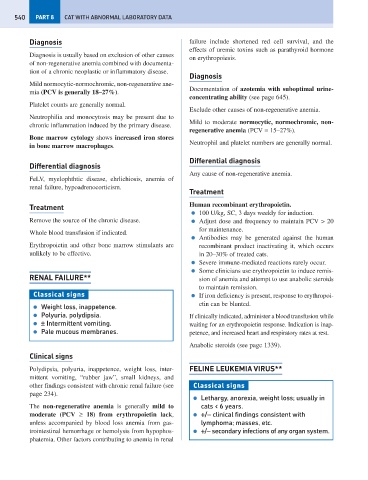Page 548 - Problem-Based Feline Medicine
P. 548
540 PART 8 CAT WITH ABNORMAL LABORATORY DATA
Diagnosis failure include shortened red cell survival, and the
effects of uremic toxins such as parathyroid hormone
Diagnosis is usually based on exclusion of other causes
on erythropoiesis.
of non-regenerative anemia combined with documenta-
tion of a chronic neoplastic or inflammatory disease.
Diagnosis
Mild normocytic-normochromic, non-regenerative ane-
Documentation of azotemia with suboptimal urine-
mia (PCV is generally 18–27%).
concentrating ability (see page 645).
Platelet counts are generally normal.
Exclude other causes of non-regenerative anemia.
Neutrophilia and monocytosis may be present due to
Mild to moderate normocytic, normochromic, non-
chronic inflammation induced by the primary disease.
regenerative anemia (PCV = 15–27%).
Bone marrow cytology shows increased iron stores
Neutrophil and platelet numbers are generally normal.
in bone marrow macrophages.
Differential diagnosis
Differential diagnosis
Any cause of non-regenerative anemia.
FeLV, myelophthtic disease, ehrlichiosis, anemia of
renal failure, hypoadrenocorticism.
Treatment
Treatment Human recombinant erythropoietin.
● 100 U/kg, SC, 3 days weekly for induction.
Remove the source of the chronic disease. ● Adjust dose and frequency to maintain PCV > 20
for maintenance.
Whole blood transfusion if indicated.
● Antibodies may be generated against the human
Erythropoietin and other bone marrow stimulants are recombinant product inactivating it, which occurs
unlikely to be effective. in 20–30% of treated cats.
● Severe immune-mediated reactions rarely occur.
● Some clinicians use erythropoietin to induce remis-
RENAL FAILURE** sion of anemia and attempt to use anabolic steroids
to maintain remission.
Classical signs ● If iron deficiency is present, response to erythropoi-
etin can be blunted.
● Weight loss, inappetence.
● Polyuria, polydipsia. If clinically indicated, administer a blood transfusion while
● ± Intermittent vomiting. waiting for an erythropoietin response. Indication is inap-
● Pale mucous membranes. petence, and increased heart and respiratory rates at rest.
Anabolic steroids (see page 1339).
Clinical signs
Polydipsia, polyuria, inappetence, weight loss, inter- FELINE LEUKEMIA VIRUS**
mittent vomiting, “rubber jaw”, small kidneys, and
other findings consistent with chronic renal failure (see Classical signs
page 234).
● Lethargy, anorexia, weight loss; usually in
The non-regenerative anemia is generally mild to cats < 6 years.
moderate (PCV ≥ 18) from erythropoietin lack, ● +/- clinical findings consistent with
unless accompanied by blood loss anemia from gas- lymphoma; masses, etc.
trointestinal hemorrhage or hemolysis from hypophos- ● +/- secondary infections of any organ system.
phatemia. Other factors contributing to anemia in renal

